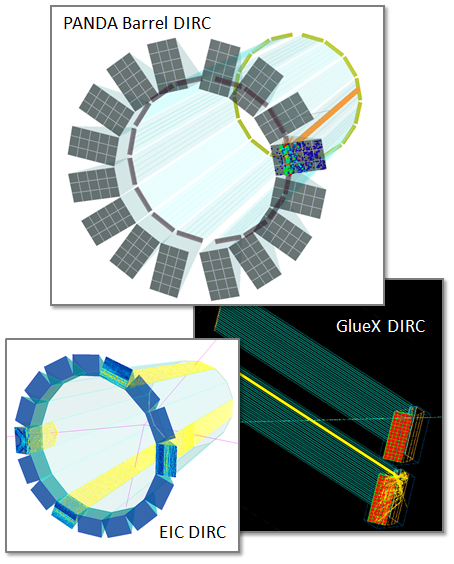Current Research Projects
|
I am a physicist and work as a senior staff scientist at the
GSI Helmholtzzentrum für Schwerionenforschung GmbH (GSI)
in Arheilgen, close to Darmstadt, Germany. PANDA Barrel DIRCAs system manager I am the project leader of the Barrel DIRC for the PANDA Detector at the FAIR facility at GSI, the primary particle identification (PID) system in the barrel region of the PANDA target spectrometer. The design for the barrel DIRC is based on the successful BaBar DIRC detector with several key improvements, such as fast timing, and a compact imaging system using focusing optics.The barrel DIRC project has moved from the R&D stage to the construction phase. Activities are focused on finalizing the production design of the focusing optics and the mechanical system components and on evaluating the detector components as the mass production ramps up. The responsibilities of the PANDA DIRC group at GSI include
DIRC-based PID for the EIC Central Detector, ePIC hpDIRCAs one of the principle investigators of an R&D collaboration of several groups in the USA and Germany, centered around the Thomas Jefferson National Accelerator Facility (JLab) and the Brookhaven National Laboratory (BNL), I have been involved in the R&D for the design and test of a barrel DIRC system for the central detector at the future electron-ion collider facility since 2011. The DIRC group at GSI contributes to the R&D by building and testing a prototype for the compact imaging region and by developing the simulation and reconstruction framework. After the initial feasibility study (eRD4) provided a proof-of-principle for a high-performance DIRC design, the R&D entered into a new phase in 2015 when the focus shifted to design optimization and the study of the combined PID performance of the experiment by forming the PID Consortium for an integrated program for Particle Identification (PID) at a future Electron-Ion Collider (eRD14), a joint effort from 25 labs and universities. The eRD103 consortium was formed in 2021 to address the remaining R&D challenges for the ePIC detector and to mitigate key hpDIRC project risks. The newest EIC DIRC consortium, EICGENR&D12, was established in 2022, dedicated to exploring innovative optical DIRC configurations and opportunities for cost reduction, performance improvement, and complementarity to the ePIC hpDIRC design.DIRC Upgrade for the GlueX ExperimentIn 2015 the GSI DIRC group joined the GlueX Collaboration at JLab to work on the design, installation, operation, and data analysis of the GlueX DIRC counter. Four of the bar boxes from the BaBar experiment were be transported to JLab in 2017/2018 and installed in GlueX to provide upgraded PID for the GlueX high-intensity runs. Our activities are focused on the development of the simulation and reconstruction software with the goal of performing tests of the DIRC PID algorithms, developed for PANDA, on GlueX experiment data. |

|